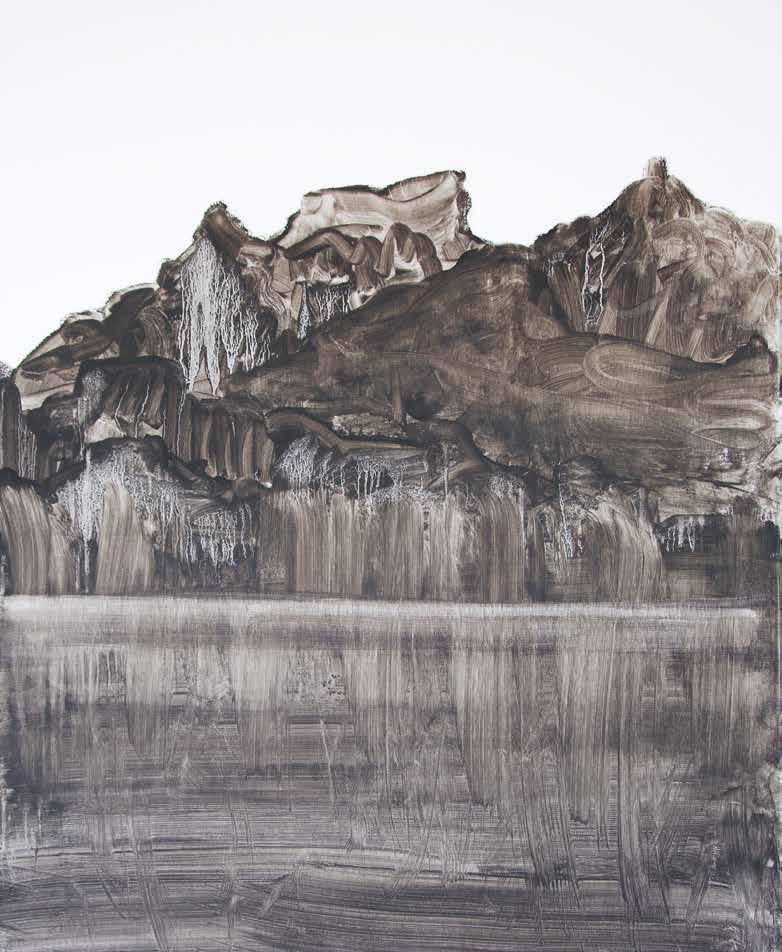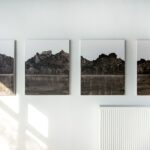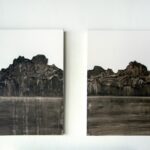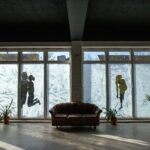Góra wzywa
Der Berg ruft
The Mountain Calls
Artysta | Künstler | artist: Patrick Huber (1959)
miejsce | Ort | place: Magistrale Kunsthalle, Karl-Marx-Straße 13, Frankfurt (Oder)
. Wszystko zaczęło się od Luisa Trenkera i jego wysokogórskiego dramatu z 1938 roku Góra wzywa, filmu, który wprowa – dził piękny i niebezpieczny świat gór do kin na północy Niemiec, ale także naj – prawdopodobniej na całym świecie. Góry stały się miejscem tęsknoty za natu – rą, miłością i przygodą. Miejscem równie niebezpiecznym jak Dziki Zachód, tyle że w zasięgu ręki. Z pewnością niewiele osób pamięta dziś Luisa Trenkera i mało kto kojarzy z nim dzisiejsze ogromne zainteresowanie górami w sztuce współ – czesnej, zwłaszcza w dużych miastach, takich jak Berlin. Istnieje jednak wiele powodów, dla których warto inspirować się artystycznie motywem gór. Jednym z nich jest to, że góry najlepiej ogląda się z dystansu. Kiedy wspinam się na konkretną górę, wszystko, co odbieram z jej piękna, to puste skały, a uwagę moich oczu odwracają szczyty sąsiednich gór i malownicze doliny. Cóż za paradoksalna zmiana perspektywy: piękno jest zawsze tam, gdzie mnie nie ma, więc tęsknota za nim nigdy nie może zostać zaspokojona. Prawdopodobnie jest to jeden z powo – dów, dla którego artyści do listy 1.187.049 już zbadanych gór w dalszym ciągu doda – ją nowe.
Eigentlich begann alles mit Luis Trenker und seinem Hochgebirgsdrama Der Berg ruft von 1938. Dieser Film transportier – te die schöne, aber gefährliche Welt der Berge über die Kinos auch in den Norden Deutschlands und wahrscheinlich auch in den Rest der Welt. Der Berg wurde zum Sehnsuchtsort von Natur, Liebe und Abenteuer. Ein Ort eben – so gefahrvoll wie der Wilde Westen, nur zum Greifen nah. Sicher erinnern sich heutzutage die wenigsten an Luis Tren – ker und kaum einer bringt den heutigen Bergboom in der aktuellen Kunst, und be – sonders der in den Großstädten wie Ber – lin, mit ihm in Verbindung. Gibt es doch viele Gründe, sich mit dem Berg künst – lerisch zu beschäftigen. Ein Phänomen u.a. ist es, dass man den Berg am besten von einiger Entfernung aus betrachten kann. Besteige ich einen Berg, sehe ich von seiner Schönheit nur noch Geröll, und mein Auge sucht schnell den Gipfel eines benachbarten Bergs oder schaut ins verlockende Tal. Was für ein parado – xer Perspektivwechsel, das Schöne ist immer dort, wo ich gerade nicht bin. Die Sehnsucht danach kann also nie gestillt werden, wahrscheinlich ein Grund dafür, dass Künstler zu den 1.187.049 erforsch – ten Bergen ständig neue hinzufügen.
It all began with Luis Trenker and his 1938 high mountain drama The Moun – tain Calls, the film that brought the beau – tiful but dangerous world of the moun – tains to cinemas in northern Germany and probably in the rest of the world. Mountains became a place of longing for nature, love and adventure. A place just as dangerous as the Wild West, only within reach. Certainly very few people today remember Luis Trenker and hard – ly anyone associates today’s mountain boom in contemporary art, especially in big cities like Berlin, with him. Yet there are many reasons to be artistically in – spired by mountains. One of them is the fact that mountains are best viewed from a distance. When I climb a mountain all I see of its beauty are bare rocks, and my eye quickly searches for the summit of a neighbouring mountain or looks into the enticing valley. What a paradoxical change of perspective: beauty is always where I am not. So the longing for beauty can never be satisfied, which is probably one reason why artists constantly add new mountains to the list of 1,187,049 that have already been explored.






